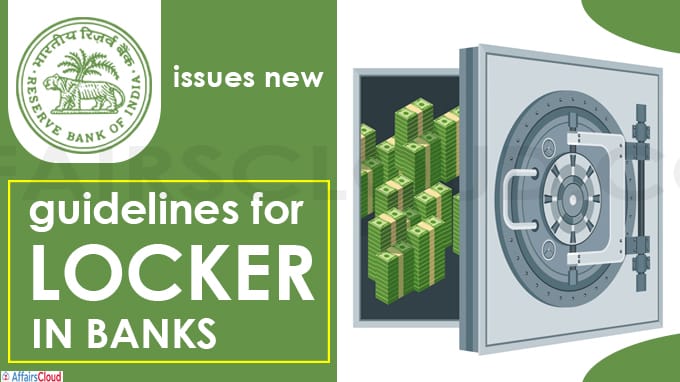 The Reserve Bank of India (RBI) has issued revised guidelines for both new and existing Safe Deposit Locker and Safe Custody Article Facility with the banks.
The Reserve Bank of India (RBI) has issued revised guidelines for both new and existing Safe Deposit Locker and Safe Custody Article Facility with the banks.
- At present, banks do not have any liability towards lockers. The guidelines would come into effect from January 1, 2022.
RBI’s Guidelines:
i.The banks are directed to incorporate a clause in the ‘locker agreement’ for prohibiting the hirer from keeping anything illegal or hazardous in lockers.
ii.Transparency: To ensure transparency in lockers allotment, the RBI mandated banks to maintain a branch-wise list of vacant lockers and a wait-list in Core Banking System (CBS) or any other computerised system compliant with Cyber Security Framework.
- The bank was instructed to acknowledge all the applications for allotment of lockers and provide a waitlist number to the customers in case of unavailability.
iii.The banks need to adopt the model locker agreement to be framed by Indian Banks’ Association (IBA).
- Banks should renew their locker agreements with existing locker customers by January 1, 2023.
iv.Compensation: The banks are instructed to compensate the customers in case of incidents such as fire, theft, burglary, dacoity, robbery, building collapse or fraud committed by the bank’s employees.
- The compensation has to be an amount equivalent to 100 times the existing annual rent of the safe deposit locker.
v.Locker rent: RBI allows banks to obtain a Term Deposit (TD), at the time of allotment only in case of a hirer neither operates the locker nor pays the rent.
- TD- It will cover 3 years’ rent along with the charges for breaking open the locker (in case of not being paid for 3 years).
- In case the customer surrendered the locker then the locker rent that was collected in advance should be refunded to them.
- The bank should not insist on the TD from the existing locker holders or those who have a satisfactory operative account.
vi.Banks are provided with the discretion to break open any locker if the rent has not been paid by the customer continuously for 3 years.
vii.Identification Code: RBI required the Banks to ensure that the identification code of the bank/branch is embossed on all the locker keys to facilitate the identification of lockers/locker ownership by law enforcement agencies (in case of need).
viii.Notification: The Banks need to send an email and an SMS alert to the registered email ID and mobile number of the customer before the end of the day to confirm the date and time of the locker operation.
ix.If the locker remains inoperative for 7 years and the hirer cannot be located (even if rent is being paid regularly) the bank could transfer the content to the customer’s nominees/legal heir or dispose of the articles in a transparent manner.
Note – The above guidelines were issued by RBI under the powers conferred by Section 35A and Sections 45ZC to 45ZF of the Banking Regulation (BR) Act, 1949, read with Section 56 of the BR Act.
Recent Related News:
The Reserve Bank of India’s Deputy Governor T. Rabi Sankar stated about the RBI’s plan for the phased introduction of a ‘Central Bank Digital Currency’ (CBDC) at the webinar organised by the Vidhi Centre for Legal Policy.
About Reserve Bank of India (RBI):
Establishment – 1st April 1935
Headquarters – Mumbai, Maharashtra
Governor – Shaktikanta Das
Deputy Governors – Mahesh Kumar Jain, Michael Debabrata Patra, and M Rajeshwar Rao, T. Rabi Sankar




